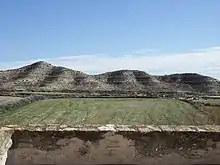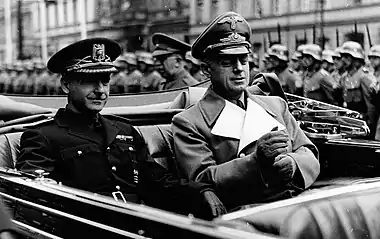Javier Ramírez Sinués
Francisco Javier Ramírez Sinués (1898–1977) was a Spanish politician and official. In the mid-1930s he approached Carlism and in 1933 to 1935 he served as a Traditionalist deputy in the Cortes. He accepted the wartime political unification into Falange Española Tradicionalista. His career climaxed during early Francoism; in 1938 to 1939 he served as civil governor of the province of Soria, and in 1939 to 1943 he performed the same role in the province of Álava. After the mid-1940s he mostly withdrew into privacy, punctuated by sporadic demonstrations of support for the Alfonsist pretender Don Juan and for Franco.
Javier Ramírez Sinués | |
|---|---|
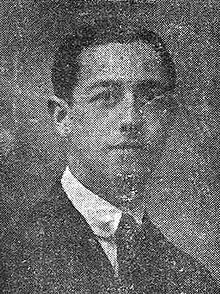 | |
| Born | Javier Ramírez Sinués 1898 Tauste, Spain |
| Died | 1977 (aged 78–79) Zaragoza, Spain |
| Nationality | Spanish |
| Occupation(s) | lawyer, landholder |
| Known for | politician |
| Political party | Carlism, FET |
Family and youth

The Ramirez family was initially related to Ariza,[1] an Aragonese town near Calatayud. The great-great-grandfather of Ramírez Sinués, Lorenzo Ramírez, left his native village of Bordalba and settled in Tauste in Western Aragón in the late 18th century.[2] In the mid-19th century his son Iñigo Ramírez Martínez was already the first taxpayer of the town,[3] owned some 170 hectares,[4] a mill and a confectionery manufacture.[5] His son and the grandfather of Ramírez Sinués, Angel Ramírez Carrera (1821-1893), purchased further 630 hectares during so-called desamortización de Madóz in the 1860s.[6] He was active in the Conservative Party, served in the provincial diputation[7] and in 1881-1886 held a seat in the Cortes;[8] his career marked the economic and political climax of the family.[9] His son Javier Ramírez Orúe (1871-1943)[10] in 1897[11] married Manuela Sinués Lambea from the neighboring Gallur (died 1943);[12] she was daughter to local terrateniente family, also enriched during the desamortización.[13]
Ramírez Orúe tried to follow in the footsteps of his father; he was also elected Conservative provincial deputy in 1896[14] and 1915,[15] in 1917 growing to president of Diputación Provincial de Zaragoza.[16] Despite renewed attempts and due to personal conflict with the Aragonese cacique family of Castellano,[17] he has never managed to obtain the parliamentary ticket. However, his party connections ensured the 1922 nomination to gobernador civil of Valladolid; following 5 months at this post he was transferred to similar role in Tarragona, but for unclear reason Ramírez resigned after just 2 months.[18] Businesswise, he was the moving spirit behind construction of the Gallur-Sádaba railway line, inaugurated in 1915.[19] In 1924-1925 he bought 11,000 ha near Alfajarín and further 10,000 ha near Farlete; historians speculate that both purchases might have been at least partially fictitious, the shady deal agreed with vending local aristocrats.[20] The transactions rendered Ramírez the 24th and then the 11th largest rural taxpayer in Aragon.[21]
It is not clear whether Javier had any siblings; neither any of the sources consulted provides information on his early education. At unspecified time, though probably at the turn of the 1910s and 1920s, he studied law, most likely at the University of Zaragoza.[22] Following military service in the local Aragón unit[23] in 1923[24] he married María de los Dolores de Círia del Castillo-Olivares, born in Ciudad Real.[25] She was daughter to Alfredo de Círia y Arbeleche, Conde de Valparaíso and Marqués de Añavete, owner of numerous estates in Aragón and elsewhere.[26] The couple settled in Zaragoza, where Ramírez Sinués practiced as a lawyer.[27] It is not clear to what extent he was involved in management of the massive rural economy of his father; some authors claim he was barely related to his native Tauste,[28] but in public he at times appeared as “agrario”.[29] Javier and Dolores had 7 children,[30] born between the mid-1920s[31] and the late 1930s.[32] None of the Ramírez Círia descendants became a public figure; neither any of 16 grandchildren from Ramírez Martín, Ramírez Días, García Ramírez and Vicente Ramírez families did.[33]
Carlist

There is no evidence of Ramírez Sinués’ public engagements during the Primo de Rivera dictatorship; information on his activity during the early Republican period is confusing. Some sources claim that he was member of Acción Popular Agraria Aragonesa,[34] the conservative organization animated by local landholders; the Ramirez property was from the onset target of expropriation designs,[35] for the time being delayed by talks about voluntary cession of some property.[36] Other sources maintain that already in 1931 Ramírez entered Comunión Tradicionalista[37] and contributed to its local weekly, Lunes.[38] During the 1933 election campaign he was initially reported as a candidate of Candidatura de Defensa Agraria,[39] which was soon re-formatted as a coalition list of Unión de Derechas; the Carlists advertised him as their candidate.[40] He was comfortably elected and joined the Carlist parliamentary minority.[41]
Ramírez was barely active in Cortes, and his interventions were related mostly to agriculture.[42] As full-time member he entered Comisión de Importaciones de Trigo, and as deputy commissions of audit, budget and war.[43] In 1934 he formed a commission investigating the October events in Barcelona[44] and afterwards he signed a related motion to bring Azaña before Tribunal de Garantias.[45] He was known mostly for initiatives related to infrastructure buildup in Aragón: development of telephone grid,[46] trade,[47] railway network,[48] hydrographic works[49] and sugar beets industry; during some of these projects he worked with another Aragón deputy, Ramón Serrano Suñer.[50]
Within Carlism Ramiréz remained in the second row; he did not enter the party executive bodies and seldom spoke at public rallies. A scholarly monograph barely mentions his name.[51] His appearances are related to religious events[52] rather than to strictly Traditionalist gatherings, mostly in Aragón[53] and exceptionally also elsewhere.[54] In Carlist propaganda he was dedicated relatively little space.[55] In terms of political strategy he joined the faction which supported a general monarchist alliance; in 1935 Ramírez was among signatories of the newly founded Bloque Nacional,[56] entered its local Aragonese presidency[57] and appeared in some common propaganda initiatives.[58] In 1935 he was appointed delegado regional of Juventudes Tradicionalistas.[59] He did not field his candidature in the 1936 elections and it is not clear whether he was engaged in fighting expropriation, which eventually affected the Ramírez properties in May 1936.[60]
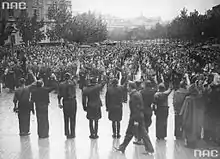
Ramírez’ fate during first years of the Civil War is not clear. Western Aragón was easily seized by the Nationalists during the first week of the conflict and it seems that as teniente de reserva[61] Ramírez joined rebel units. Some later press notes claimed he volunteered as “combatiente de primera hora” and headed "Tercio de Aragón”,[62] others note his important role “en la Milicia”.[63] Also the British scholar maintains he was incorporated in requeté.[64] Others maintain he acted as “capitan de complemento” of an infantry unit.[65] His military career ended in the summer of 1938, when he served in Regimento de Infantería de Gerona,[66] deployed at combat positions in Balaguer in western Catalonia.[67] He was decorated with Medalla de la Campaña, two red crosses and a Cruz de Guerra.[68]
Civil governor
.jpg.webp)
In late August 1938 Ramírez was appointed the civil governor of Soria;[69] it took him few weeks before he left his combat unit and assumed the post.[70] None of the sources consulted traces the mechanism of his elevation, but one author suggests that it might have been related to his acquaintance with Serrano Suñer. Ramírez was member of his network of Aragonese associates and his appointment formed part of Serrano-driven “aragonese overrepresentation” among the governors of the era,[71] especially that Ramírez had no reservations about the 1937-declared forced political unification and Carlist amalgamation into a new state party; press notes claimed that he “enthusiastically joined” FET.[72] His spell in Soria lasted almost exactly a year[73] and it proved completely routine. Following initial ritual declaration of loyalty to Franco, which nevertheless contained references to “delicada misión” and “más imparcial rectitud”,[74] Ramírez was noted in public as engaged in conventional administrative tasks, marked by confronting shortages and hardships of wartime era.[75] Apart from numerous propaganda[76] and religious[77] events, the most ambitious project was about major refurbishment of water supply network for the residents of Soria.[78]
In late August 1939[79] Ramírez was released from his post in Soria and appointed to the parallel role of civil governor of Álava,[80] where he replaced another Traditionalism-related gobernador, Francisco Sáenz de Tejada y Olozaga.[81] His assignment in Vascongadas lasted almost 4 years, until July 1943. His term was unusually long compared to other governor appointments of this period, which barely endured 2 years;[82] it was related to Ramírez’ personal links with Serrano Suñer[83] and Rodezno.[84] Apart from the usual propaganda and admin tasks, it was marked in particular by his attempts to address the problem of supplies.[85]
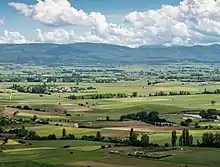
In political terms Ramírez was trapped in internal power struggle between radical Falangists, generic conservatives and Carlists, but scholarly opinions on his role differ. One author claims that his arrival provided a new impulse for implementation of falangism in the province,[86] though he suggest that the key role was played by the new provincial FET leader, Alfonso Sanz Gómez.[87] Other historian maintains that both Ramírez and his predecessor “no se mostraron excesivamente adictos ni al Partido ni a las políticas que éste quería llevar cabo”.[88] One more scholar maintains that under his leadership national-syndicalism in Álava was reduced mostly to declarations, and that in fact traditional conservative groupings gained predominance by integration within the regime structures.[89] According to this reading, Ramírez went well with the caciquista current related to the Oriol family, which represented “pragmatismo y tecnicismo”.[90] Faced with the conflict between Oriolista-dominated diputación provincial and local Falange, Ramírez tended to side with the former,[91] and supported individuals of Carlist background endangered by purges.[92] However, he also presided over gradual domestication and watering-down of Alavese Carlism.[93]
Withdrawal into privacy
When in the summer of 1943 Ramírez ceased as the civil governor he was not appointed to any other official post in the administration. None of the sources consulted provides any insight as to his departure from the civil servant service. In particular, it is not clear whether it was related to the 1942 marginalisation of his political sponsor, Ramón Serrano Suñer. Some authors suggest that in Álava he fell victim of the new practice of unifying the roles of civil governor and provincial FET leader, but they do not shed light on termination of his official career in general.[94] It is unlikely that he fell from grace, as in the mid-1940s the tightly censored press occasionally mentioned his name as the ex-gobernador.[95] Some time between the mid-1940s and the mid-1950s for unspecified time he served as director of Compañía Telefónica, one of major telecommunications companies in Spain.[96]
During the next 30 years and until his death Ramírez disappeared almost entirely from the public eye. It is unclear whether he resumed his lawyer career in Zaragoza or rather turned towards the rural economy, inherited from his late father. Very sporadically he appeared in the societé columns,[97] usually in relation to various family events. In the early 1950s it might have appeared that his re-entry into politics was near; in 1953[98] and 1954[99] he was a few times admitted by fellow ex-Carlist, the Cortes speaker Esteban Bilbao. In 1954 he appeared at an official religious event, highly flavored with Traditionalism, this time along another ex-Carlist, the minister of justice Antonio Iturmendi.[100] Franco talked to him during official audiences in 1954[101] and 1956,[102] but the subject of their talks is unknown. However, no official appointment materialized.
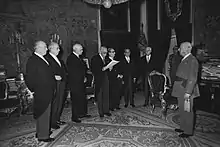
After official unification Ramírez did not engage in Carlist structures. Informally he maintained links with so-called Rodeznistas, the faction co-operating with the regime and increasingly leaning towards dynastical leadership of the Alfonsist pretender, Don Juan.[103] This stand was officially acknowledged when in late 1957 Ramírez joined some 60 Carlists who visited the claimant in his Estoril residence; following Don Juan's declaration which fully embraced traditionalist principles, the so-called “estorilos” declared him the legitimate Carlist heir.[104] The move did not impair Ramírez relations with the regime, as in 1960 he was awarded Gran Order de la Orden de Merito Civil.[105] Another of his isolated political appearances was dated 1969, when following expulsion of the Javierista pretender Don Carlos Hugo the Franco regime was eager to demonstrate that caudillo still enjoyed unconditional Carlist support. Ramírez appeared along “former traditionalist combatants” led by Ricardo Oreja Elosegui; in name of their fellow ex-requetés the group delivered the loyalty address.[106] This proved the last Ramírez’ public representation. His 1977 death went entirely unnoticed.[107]
See also
Footnotes
- Marcelino Cortés Valenciano, Tauste en la encrucijada: 1850-1923. Radiografía de la Villa a través de la familia Ramírez, [in:] Tauste en su historia: actas de las III Jornadas sobre la Historia de Tauste, Zaragoza 2003, ISBN 8460635554, p. 105
- Cortés Valenciano 2003, p. 105
- Cortés Valenciano 2003, p. 112
- Cortés Valenciano 2003, p. 113
- Cortés Valenciano 2003, p. 114
- Cortés Valenciano 2003, p. 116
- Cortés Valenciano 2003, p. 119
- see the Ramírez Orúe ticket at the official Cortes service, available here
- Cortés Valenciano 2003, pp. 118-128
- he is wrongly listed as „Javier Ramirez de Orne” at the indexing service of the Zaragoza municipal cemetery, see here
- La Dinastía 31.01.1897, available here
- Pensamiento Alaves 12.05.43, available here
- Francisco Javier Lambán Montañés, La reforma agraria republicana en Aragón, 1931-1936 [PhD thesis Universidad de Zaragoza], Zaragoza 2014, p. 383
- Cortés Valenciano 2003, p. 129
- Cortés Valenciano 2003, p. 131
- Cortés Valenciano 2003, pp. 131-132
- first with Tomás Castellano Villarroya and then his son Tomás Castellano Echenique, Cortés Valenciano 2003, pp. 129, 132
- Cortés Valenciano 2003, p. 133
- Cortés Valenciano 2003, p. 138
- Lambán Montañés 2014, pp 346, 460
- Lambán Montañés 2014, p. 351
- Cortés Valenciano 2003, p. 141
- Ejército de la Península 1925, available here
- El Debate 29.12.23, available here
- El Avisador Numantino 08.07.39, available here, Gabriela Sierra, Francisco Gracia, Zaragoza en el Congreso de los Diputados, Zaragoza 2012, ISBN 9788499111636, p. 57
- Castillo-Olivares genealogical site, available here
- Guillermo Sáez Aznar, Aquellos Abogados de Provincias. La red aragonesa de Serrano Suñer durante la Segunda República, [in:] La Segona República. Cultures i projectes polítics. Congrés Internacional d’Història, Bellaterra 2016, available here
- Sierra, Gracia 2012, p. 57
- La Libertad 28.11.33, available here
- named Juana, José Andrés, Carmen, Pedro, Dolores, Pilar and Concepción, Pablo del Castillo-Olivares y Jiménez, Historia del apellido del Castillo-Olivares, available here
- the first child was Juana. The second one, José Andrés, was born in 1927, see the Zaragoza municipal cemetery database, available here
- the last one, María Concepción, was born in 1938, El Avisador Numantino 10.12.38, available here
- surnames referred after Pablo del Castillo-Olivares y Jiménez, Historia del apellido del Castillo-Olivares, available here
- Guillermo Sáez Aznar, La sombra de gobernación, [in:] Jerónimo Zurita 93 (2018), p. 193
- already in 1931 the local UGT unit claimed that the Alfajarín estate is not cultivarted and serves only for hunting and growing rabbit population; they demanded action, Lambán Montañés 2014, p. 461
- Lambán Montañés 2014, p. 461
- Melchor Ferrer, Historia del tradicionalismo español, vol. XXX, Sevilla 1979, p. 79
- Pensamiento Alaves 28.08.39, available here. According to later opiniony, “persona de dotes intelectuales y religiosas, reflejadas en sus artículos en el semanario tradicionalista”, Iker Cantabrana, Octavistas contra Oriolistas. La lucha por el control de las instituciones, [in:] Antonio Rivera (ed.), Dictadura y desarrollismo. El franquismo en Alava, Vitoria 2009, ISBN 9788496845305, p. 138
- La Voz de Aragon 14.11.33, available here
- Pensamiento Alaves 23.11.33, available here, El Siglo Futuro 11.11.33, available here
- see his ticket at the official Cortes service, available here
- Sierra, Gracia 2012, p. 57
- referred after Sierra, Gracia 2012, p. 57
- La Prensa 26.10.34, available here
- La Libertad 14.03.35, available here
- La Voz de Aragon 27.03.34, available here
- La Voz de Aragon 26.07.34, available here
- El Adelanto 09.01.35, available here
- La Voz de Aragon 03.09.35, available here
- La Voz de Aragon 16.04.35, available here
- see Martin Blinkhorn, Carlism and Crisis in Spain 1931-1939, Cambridge 2008, ISBN 9780521207294
- see e.g. the 1934 religious act in Centro Católico, in Congregación de San Luis, in intronization of Sacred Heart of Jesus, grand religious rally in Zaragoza, and his presidency in some of these gatherings, Pensamiento Alaves 14.06.34, available here, La Voz de Aragon 07.05.35, available here, La Voz de Aragon 05.11.35, available here
- see his presence during a 1934 rally in Borja, Tradición 01.07.34, available here, or during a 1935 gathering in Zaragoza, El Siglo Futuro 12.03.35, available here
- the exceptional case was his presence during launch of new printing machinery of the Madrid daily El Siglo Futuro, see Pensamiento Alaves 24.04.35, available here
- in a Carlist propaganda booklet he was featured on 1 page with very vague information provided, hailed as “hombre de estudio”, “prestigio intelectual”, and "ferviente propagandista de la Tradición", El Tradicionalismo español ante la opinión pública, s.l. 1934, p. 105
- Ferrer 1979, p. 106
- La Voz de Aragon 01.01.35, available here
- e.g. in July 1935 he joined the initiative to build a monument to Cid Campeador in Burgos, Diario de Burgos 19.07.35, available here
- Ferrer 1979, p. 79
- in April of 1936 Instituto de Reforma Agraria embarked on peculiar and singular policy with regard to some properties in Aragón, Sobradiel and Alfajarín; it authorized occupation of lands of Javier Ramirez Orue and then distributed some 6,000 ha among 468 farmers, Lambán Montañés 2014, pp. 451, 461. Javier Ramirez protested to IRA and his last document was dated June 10, 1936; he claimed the estate has been hipotecated, Lambán Montañés 2014, p. 469. Following Nationalist takeover of Western Aragón Ramirez Orúe addressed Comisión de Agricultura of Junta Técnica del Estado and got most of the expropriated area restituted to him in December 1936, Lambán Montañés 2014, p. 470
- since 1925 Ramírez was ranked as teniente, Anuario Militár de España 1926, available here
- Pensamiento Alaves 19.07.40, available here. There were 5 Carlist tercios raised in Aragon, but none was named "Tercio de Aragon", compare Julio Aróstegui, Combatientes Requetés en la Guerra Civil Española (1936–1939), Madrid 2013, ISBN 9788499709758, pp. 523-580
- El Avisador Numantino 31.08.38, available here
- Blinhorn 2008, p. 260. However, Ramírez was not noted in operational history of either the Aragonese or any other requeté battalions, compare Aróstegui 2013, pp. 523-580 (for Aragonese battalions)
- El Avisador Numantino 31.08.38, available here
- El Avisador Numantino 05.07.39, available here
- Pensamiento Alaves 05.08.38, available here
- El Avisador Numantino 25.11.39, available here
- El Diario Palentino 30.08.38, available here. One author wrongly claimed that he was the governor of Soria in 1933-1935, see Cortés Valenciano 2003, p. 141. This erroneous information has already been repeated by few other authors
- he took office on September 12, 1938, Labor 12.09.38, available here
- compare Sáez Aznar 2016
- El Avisador Numantino 31.08.38, available here
- until 30 August 1939, El Avisador Numantino 30.08.39, available here
- El Avisador Numantino 14.09.38, available here
- compare his efforts related to flower supplies, El Avisador Numantino 28.01.39, available here, to implementation of “plato unico” scheme, El Avisador Numantino 27.05.39, available here, or to charity, El Avisador Numantino 28.12.38, available here
- compare a rally to honor colonel Moscardo, Labor 26.09.38, available here, a general patriotic gathering, El Avisador Numantino 08.02.39, available here, or to celebrations related to Nationalist troops entering Madrid, El Avisador Numantino 29.03.39, available here
- see e.g. his appearances during religious acts in October 1938, El Avisador Numantino 05.10.38, available here, in April 1939 April, El Avisador Numantino 08.04.39, available here, or in May 1939, El Avisador Numantino 10.05.39, available here
- El Avisador Numantino 23.08.39, available here
- shortly prior to Ramírez’ move from Soria to Vitoria he was visited by 2 Carlists and governors of neighboring provinces, José María Sentis Simeon (Guadalajara) and Antonio Iturmendi (Zaragoza); it is not clear whether it was a form of co-ordinating personal policy, El Avisador Numantino 16.08.39, available here
- El Avisador Numantino 30.08.39, available here
- Iker Cantabrana Morras, Lo viejo y lo nuevo: Diputación - FET de las JONS: la convulsa dinámica política de la "leal" Alava (segunda parte: 1938-1943), [in:] Sancho el sabio: Revista de cultura e investigación vasca 22 (2005), pp. 141-142
- nominations of 1939 lasted on average 1,89 years, these of 1943 lasted 4,22 years, Martí Marín i Corbera, Los gobernadores civiles del franquismo 1936-1963: seis personajes en busca de autor, [in:] Historia y política: Ideas, procesos y movimientos sociales 29 (2013), p. 252
- e.g. in September 1939 Serrano visited Ramírez on his way from Gipuzkoa to Madrid, Pensamiento Alaves 21.09.39, available here
- e.g. in September 1939 Ramírez was visited in Vitoria by Rodezno, Pensamiento Alaves 09.09.39, available here
- Pensamiento Alaves 11.11.39, available here, also Pensamiento Alaves 18.03.40, available here
- reportedly in Alava “tras el periodo de normalización ... se abrió en Alava un nuevo ciclo de impulso al partido único. El primer encargado de poner en práctica este despliegue fue Javier Ramirez Sinués”, Iñaki Fernández Redondo, El fascismo vasco y la construcción del régimen franquista, 1933-1945, Valencia 2021, ISBN 9788491347743, p. 73
- Fernández Redondo 2021, pp. 73-74
- Cantabrana 2009, p. 145
- Cantabrana Morras 2005, p. 142
- Cantabrana Morras 2005, pp. 149-150
- Cantabrana Morras 2005, pp. 155-156
- see the case of Sáenz de Ugarte, targeted for expulsion for FET and supported by Ramírez, Cantabrana Morras 2005, p. 156
- Cantabrana Morras 2005, p. 144
- Cantabrana 2009, p. 145
- Duero 25.07.44, available here
- ABC 15.01.55, available here
- Nueva Alcarria 07.04.51, available here
- El Adelanto 31.10.53, available here
- La Vanguardia 13.02.54, available here
- Hoja Oficial de la Provincia de Barcelona 26.04.54, available here
- Diario de Burgos 11.02.54, available here
- Imperio 09.02.56, available here
- Ferrer 1979, p. 79
- César Alcalá, D. Mauricio de Sivatte. Una biografía política (1901-1980), Barcelona 2001, ISBN 8493109797, p. 140
- Diario de Burgos 01.04.60, available here
- Diario de Burgos 27.03.69, available here, La Vanguardia 27.03.69, available here
- none of the digitalized press titles acknowledged his death. Its date is known merely thanks to digitalized database of individuals buried at the Torrero municipal cemetery in Zaragoza, see here
Further reading
- Iker Cantabrana Morras, Lo viejo y lo nuevo: Diputación - FET de las JONS: la convulsa dinámica política de la "leal" Alava (segunda parte: 1938-1943), [in:] Sancho el sabio: Revista de cultura e investigación vasca 22 (2005), pp. 139–169
- Marcelino Cortés Valenciano, Tauste en la encrucijada: 1850-1923. Radiografía de la Villa a través de la familia Ramírez, [in:] Tauste en su historia: actas de las III Jornadas sobre la Historia de Tauste, Zaragoza 2003, ISBN 8460635554, pp. 103–156
- Francisco Javier Lambán Montañés, La reforma agraria republicana en Aragón, 1931-1936 [PhD thesis Universidad de Zaragoza], Zaragoza 2014
- Guillermo Sáez Aznar, Aquellos Abogados de Provincias. La red aragonesa de Serrano Suñer durante la Segunda República, [in:] La Segona República. Cultures i projectes polítics. Congrés Internacional d’Història, Bellaterra 2016 [online]
